Trent Dalton’s tales from the bunker: ‘Let me tell you about the best street in Australia...’
Foster kid Jack is 9yo and he hasn’t had an easy life. He was living with his sister — then COVID-19 kicked in.
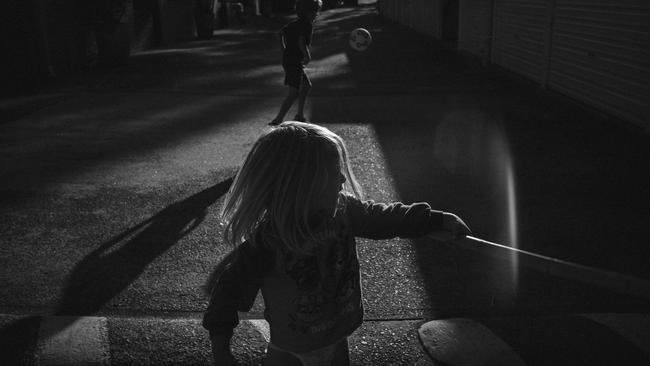
Let me tell you about the best street in Australia. It’s the one Jack lives on. Jack is nine years old and he hasn’t had an easy life. He’s a foster kid who moved in to his current foster home in the western suburbs of Adelaide a few years ago with his older sister, Anna, who has special needs. Jack and Anna aren’t their real names but they’re the names their foster dad, Glenn, uses when he writes to tell me about how much he cares for these two kids in care.
Jack lives with anxiety and what Glenn calls a “toxic shame” from events that occurred before he knew him. Jack had anger issues when he first moved in. Minor and major explosions, sometimes 30 a day. “It was crazy,” Glenn says. “I couldn’t work out how a four-year-old could go from zero to 10 in a nanosecond. Then his psychologist told me he’s actually going from eight to 10 – there was no zero point to speak of. The anger was just bubbling below the surface always, waiting for a trigger.”
Glenn and his wife persevered. They had a wide support network of their five adult birth children and their families. And when the explosions came, they had a kind of mantra that pulled them through: “We haven’t come this far to only come this far”. Eventually, with the kind of love and trust that can only be proven over time, they helped Jack bring his “eight to 10” down to “three to five” and then down far enough, even, that he found the zero point that, in a perfect world, he would have started out with. But still the explosions would come and Jack’s shame would return with them. “It’s too hard, Dad, just take me back,” Jack would say to Glenn. And Glenn would calmly remind Jack of the mantra. We haven’t come this far to only come this far.
“Then came the virus,” Glenn says.
In the last week of school before Easter break Jack coughed in class and was sent home for the day by his teacher. And Jack’s anxiety went home with him. “This virus brought his default back up to seven or eight again,” Glenn says. “A lot of angry outbursts each day.” Once again, he phoned the psychologist, who recommended that Glenn sit Jack down and ask him to express his feelings. “Turns out, he was worried about us getting sick,” Glenn says. “He was worried about us dying and leaving no one to look after him and his sister. Big feelings for this little man who told us that he’d waited a long time to find us.”
For months Jack had been looking forward to an Easter caravan trip to Robe – a glorious coastal town 350km from Adelaide – but that had to be cancelled as the virus made its terrible march across the globe. Then Glenn was struck by an idea. If he couldn’t bring Jack to Robe, maybe he could bring Robe to Jack. He would turn the whole street into a tourist town. A ridiculous notion, to be sure, but one his long-time neighbours embraced wholeheartedly. Glenn turned his front yard into the “Robe Camping Park”. Jack and Anna made a sign: “Welcome to Robe”. No less than nine families in the street dropped by the imaginary coastal camping park to soak up the serenity. “How about them ocean views?” they marvelled, staring out to nothing but brown brick suburbia. “Love the smell of the sea,” they said, smelling nothing but the wine in their plastic cups and sausages on the barbecue. And Jack howled with laughter at the beautiful silliness of it all.
“It was almost like we really were away,” Glenn says. “With everyone enjoying a new type of socialising, everyone reaching out to one another... Our street of wonderful people, who all know our kids’ names and always make an effort to befriend them. It really does take a lot of people to raise any child, even more so with children in care.
“We are so much better equipped now to help Jack feel safe and loved. We reset at the end of every day and he sleeps like a log for 10 hours each night. We’re still working out what we can and can’t do, but Jack knows there is a place for him now. He knows that he belongs here. He belongs to us. He belongs to his neighbourhood, his street, his friends and his family. He belongs.”
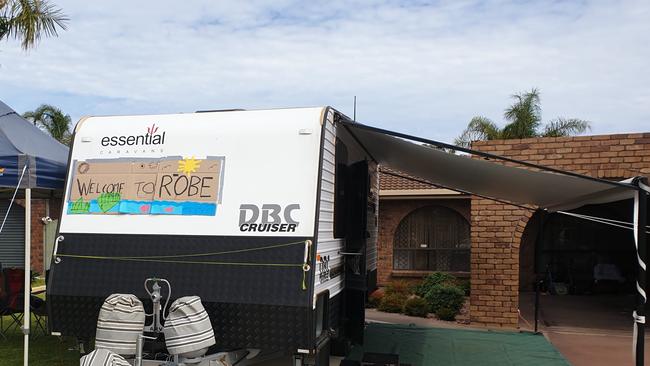
Let me tell you about the best road in Australia. It’s the one Harry and Greta live on in Winslow, a town of 300 people north of Warrnambool, Victoria. Harry Holland and his wife, Lonni, moved there in January. Their “bunker” is a home overlooking a lake and rolling fields. For years living in Melbourne, they’d resisted the urge to throw out a homemade letterbox that Harry had constructed on a whim one restless day many years ago. “My wife carefully decorated it with wildflowers and natives and butterflies,” Harry says. “Over the years the letterbox stayed wrapped, but not forgotten, in a black garbage bag in the garage.
But in January this year – 20 years or so later – it came to Winslow with them. And then the world stopped turning. The pandemic saw us retreat behind closed front doors. We turned our heads to our television sets and our Twitter feeds and Harry Holland turned his head to his old homemade letterbox. It just felt to him like the right time to erect a letterbox painted with butterflies in bright yellows and blues and greens.
“Last week I took down the old metal letterbox and put up the painted one on the roadside,” he says. “A bit of a milestone for us: we’re here now. But it sticks out a bit, I thought. Maybe too loud? Maybe it will get vandalised?”
The next day Harry and Lonni returned from the shops to find a piece of paper tucked inside it. “To our surprise it was a coloured drawing with a message: ‘Hello, I love your letterbox because the flowers and the butterfly are beautiful. From Greta.”
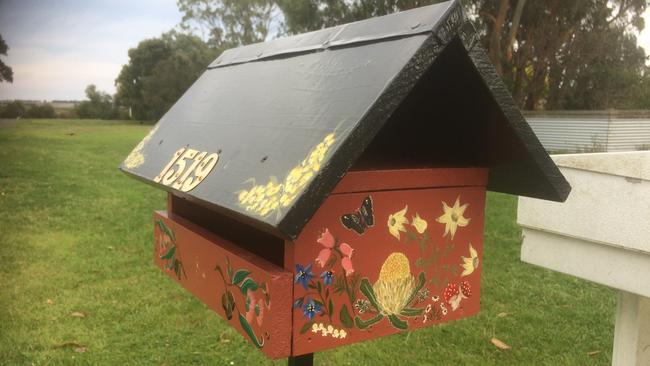
Greta’s drawing was a colourful sketch of Harry’s letterbox. A tribute, of sorts. “My first reaction was, ‘Who is Greta?’” Harry says. “What a gift. We know Greta is young, judging by her drawing, and must live not too far away. She must have noticed our loud letterbox while going for a walk. I thought I’d like to contact Greta, but how to get her a message not knowing where she lived?”
The letterbox held the answer. Harry wrote a message back to Greta on a card. He described how delighted he was to receive her drawing and how it was currently magnetised to his fridge, where all the world’s finest art resides. “I said I imagined that her letter had made our letterbox smile for two reasons,” Harry says. “First, because it could now fulfil its purpose of receiving mail after so many years in a garbage bag. And second, because it was able to receive mail like Greta’s, which made us feel welcome in our new community. Virus or no virus. But a letter with no address? ‘I know,’ I thought, ‘I’ll put the card in a plastic bag and stick it on the outside of our letterbox’.” He scrawled two words on the envelope: For Greta. “Coming home from another trip into town yesterday, the plastic bag was gone,” Harry says.
On Good Friday, Harry looked in his letterbox and found another surprise: a handwritten note and drawing plus two Easter eggs in an envelope with an address for Greta. And now Harry has another reply he wants to send to Greta, on spec, via a national weekly magazine. “Now both of your letters are on our fridge, Greta,” he says. “We will write and thank you that in this time of shutting down, of bunkers and not touching, you touched us and reminded us of a perfectly good way to keep in touch. So, don’t forget to check your letterbox for a letter, Greta.”
A remarkable concept, really. Lay a strip of bitumen running down the middle of two rows of houses. Find enough strangers to fill those houses and then ask them all to live side-by-side in peace and harmony. For years. For decades.
In a street in Perth, Barbara and her husband organise a “Distancing Disco”. Neighbours spaced out at a safe distance getting their Bee Gees on. Whether you’re a brother or whether you’re a mother, you’re stayin’ alive. That’s not just a lyric anymore from the Brothers Gibb, that’s a directive.
Amid the disco beats, Barbara has a long chat to a neighbour who lives alone and is feeling anxious about the pandemic. Barbara realises the woman is bordering on depression and tells her about Grow, a mental health organisation that’s been greatly assisting Barbara with her own emotional wellbeing. All of this deep life-and-death talk happening beneath the infectious rhythms of Stevie Wonder and the Jackson Five. Because that’s how we live now. You keep dancing and I’ll grab you that number to my psychologist. Grow’s been offering a series of free online programs, Barbara says, and group meetings to respond to what it calls the “profound impact Covid-19 has had on the mental wellbeing of Australians”. “They’re saving lives,” Barbara says. And maybe Barbara is, too.
Anne-Marie lives in a street in inner-Brisbane with her wife, Nell, and an unwelcome lodger named Anxiety. Her anxiety has been with her so long she decided to give it a capital “A” name. “Anxiety, of course, loves Covid-19,” Anne-Marie says. “In late March when friends, colleagues and family were ‘hoping for the best’, Anxiety was ‘planning for the worst’. Swollen with self-importance, Anxiety pushed me out of bed to ruminate on the couch in the wee small hours. I found the only way to keep Anxiety at bay was to leave no space in my mind – I could hardly keep track of the book I was reading, multiple TV programs I was watching, the true crime podcasts I listened to while running. My head was full of fictitious plots, people and places all mashed together. Anything to banish those scenes of Covid-19 news: people ill, out of work, in body bags. I was alternately manic and paralysed. I was unpredictably and inappropriately tearful. In parallel, our dear friend was nearing the end of her too-short life, succumbing to the aggressive brain cancer diagnosed in February the year prior. Ever generous to the end, she left this world a scant week before the worst of the Covid-19 restrictions were enforced, allowing us to honour her at a large and joyous ceremony.”
Anne-Marie clearly recalls the early morning in April when a single thought cleared everything else from her crowded mind. “For f..k’s sake,” she told herself. “Get a grip.” She developed an action plan that morning. Have tasks to complete. Exercise. More family videoconferences, fewer true crime podcasts.
“Now we three – Nell, Anxiety and I – are doing OK in the bunker,” she says. “I have rational fears about what is a truly awful situation, but I am grateful. Grateful that we still have work, that those closest to us are well, that we won the lottery of living in this lucky country, that we have each other. Nell and I dance in the kitchen and Anxiety sulks elsewhere. We walk our neighbourhood and Anxiety lags behind. We’ve planted sunflowers, we’ve bought kittens. Anxiety likes none of these things. Especially not the kittens.”
In inner-city Melbourne, Elly Ronk takes a walk through Fitzroy Gardens on a Tuesday. She sees no cars, no buses, no trucks hauling through the CBD. No planes overhead. No double-decker tourist buses. No more weddings in Fitzroy Gardens. Only birdsong. And a father teaching his young daughter how to ride her bike. She’s reluctant at first to sit in the saddle and there are tears but then there is courage and then there is the turning of bike wheels and then there is laughter again in Fitzroy Gardens. Because it gets goods. It always gets good.
Elly pads slowly back home along her street and she sees couples playing cards on verandas, doors open, music on. She sees a woman watering her garden, beautifully dressed and made-up as if she’s going to dinner at a fine restaurant but Elly realises there are no restaurants to go to and the woman has more than likely dressed up to simply step outside her front door to her garden. Elly walks on along her street and sees kids playing in the outdoors, sun shining on autumn trees around them, and it feels like she’s back in the ’60s. This must be the best street in Australia, she tells herself. Something about the light. Something about the peace. She returns home and logs in to an online sketching class with the National Gallery of Victoria. Later, an online Q&A session with the Australian Institute of Professional Photography. At night she tucks herself into bed with a Hilary Mantel and tells herself something she’d already known before dinner. Today was a good day.
In Queensland, Patsy from Caboolture, who told us a fortnight ago about MOH (My Other Half) and his kind-hearted purchase of half a goat from an embattled local butcher, has left her street behind. She’s been travelling around the world, travel restrictions be damned. “A friend invited me to join ‘View From My Window’ on Facebook,” she says. “Well, whoever thought of this needs to be nominated for a peace prize. You take a picture from your window and post it, describing where you live. That’s it. So this past week, sitting up in the comfort of my bedroom, I’ve travelled around the world, read some beautiful words of encouragement from women, some really sad ones who have lost a loved one from this cruel, cruel virus, and I’ve visited every country in the world. Seen the snow falling in Finland, the magnificent colour of spring flowers in Canada, a sunrise in Pakistan. I just loved the backyard in Brisbane with the tent and fire burning and the improvisation of a weekend away. The daffodils are all out in Indiana and the cherry blossoms in Japan. It’s raining in East Sussex and it’s blue skies in Dubrovnik. I saw the whole world for nothing. No cost, no politics, and from the safety of my own home. P.S. I did colour my hair lilac this week and MOH said nothing. Week five, I’ll try green.”
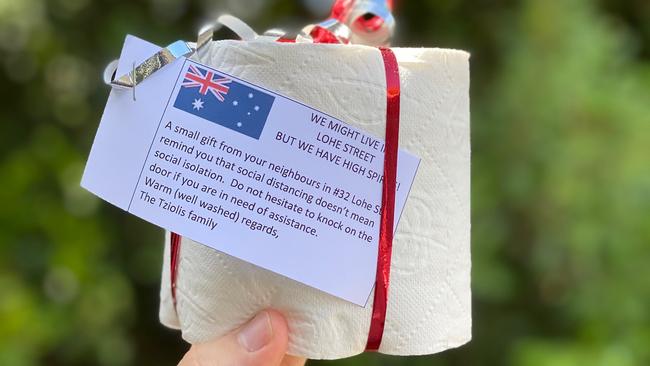
Let me tell you about the best street in Australia. It’s the one Theresa Stolz lives on. Lohe Street, Indooroopilly, in Brisbane’s western suburbs. A street of only 15 houses. “A relatively well-off street,” Theresa says. “A mix of retirees, families with young adults at home, some uni students and families with school-age kids.” Multicultural, too. Families from Japan, Italy, South Africa, Scotland.
Six weeks ago, when the world was waking up to the spread of Covid-19, Theresa and her family came home to find a roll of toilet paper wrapped in red ribbon with a message wedged in their screen door. A single roll of elegantly decorated dunny paper. No Home Brand cheap stuff, either. “Bear in mind this was when it seemed we as a nation had gone berserk in the shops over this simple but critical item,” Theresa says. It was a gift from the newest neighbours in the street.
“We might live in Lohe Street but we have high spirits!” the message read. “A small gift from your neighbours in #32 to remind you that social distancing doesn’t mean social isolation. Do not hesitate to knock on the door if you are in need of assistance. Warm (well washed) regards.”
“It gets better though,” Theresa says. “These same neighbours – with another, even newer set of neighbours – then organised a street catch-up, isolation style.” Theresa’s family ventured to the top of their driveway and conversed at a distance with no less than seven families they’d never properly met before, despite the fact some had lived on the street for 13 years. Now an annual Lohe Street Christmas party is in the works. “And it all started because of a bog roll!” Theresa says.
Let me tell you about the best street in Australia. It’s the one I live on. Seven houses in a cul-de-sac. Last weekend we had socially distant driveway drinks to welcome a couple of Estonian backpackers my neighbours have taken in. Across Australia, out-of-work backpackers who can’t get home are being taken in by families with spare rooms and big hearts. One of these cheerful Estonians plays guitar and they’re more than happy to sing for their supper. So the Estonians sing their songs now and the autumn sun shines bright and my daughter tends the vegie patch outside the louvre window of my bunker. She’s started doing this thing where she pretends to be a presenter from Gardening Australia and films herself on the iPhone. “Welcome back guys,” she says. “Today I want to tell you about Mum’s new marigolds…”
Upstairs, her sister is on a Zoom craft club with some buddies. They’re making signs that can hang from her bedroom doorknob: “Tips for entering my room: #1 Don’t come in. #2 Walk away. #3 Never come back.” Her mum, maker of marigolds, is in the kitchen making cauliflower soup.
“What the hell does any of this matter?” A voice from the bookshelf of my bunker. My late dad’s dead pet stonefish in a jar, Keef, talking from his bookshelf perch between Anna Karenina and A Brief History of Time. Keef the dead stonefish who talks to me in private with a voice like Alf from Home And Away.
“Why you writin’ all that flamin’ garbage?” Keef says.
“What garbage, Keef?”
“That cauliflower soup garbage,” Keef barks. “There’s people dying around the world.”
“I know.”
“People losing their jobs left, right and centre,” Keef hollers.
“I know.”
“And you’re writin’ about cauliflower soup and door signs and bloody marigolds? Who gives a stuff about marigolds at a time like this?”
I look through the bunker window to find my daughter again in the vegie patch, her fingers shifting aside a clump of sugar cane mulch to let a crowded marigold feel more sun.
“She does, Keefy,” I say. “She does.”
To share your bunker tales, email Trent Dalton at thebunkertales@gmail.com



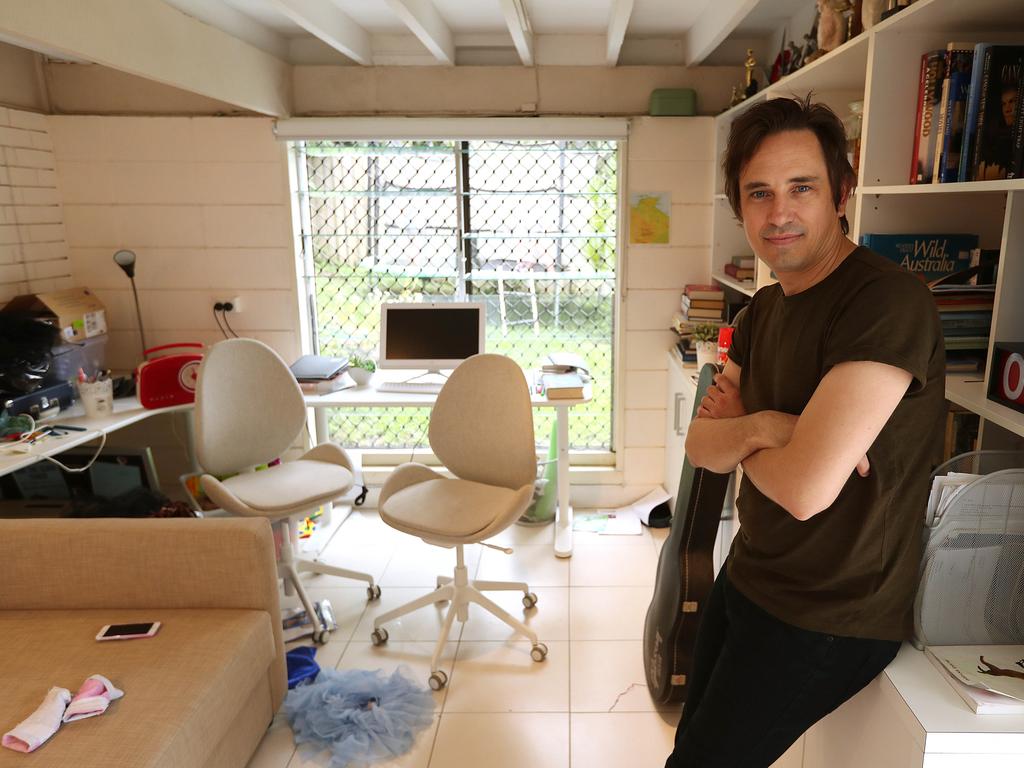


To join the conversation, please log in. Don't have an account? Register
Join the conversation, you are commenting as Logout